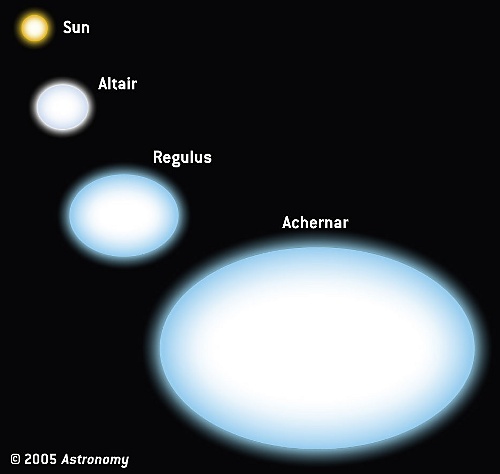







| BOOKS | F. A. Q. | ARTICLES | TALKS | ABOUT KEN | DONATE | BEYOND OUR KEN |
|---|
By Ken Croswell
Published on Astronomy.com (January 19, 2005).

Regulus, the brightest star in Leo the Lion, isn't round, say astronomers in the United States. Instead, its rapid spin flattens the star into the shape of a pumpkin.
Regulus marks Leo's heart and is the 21st brightest star in the night. It's a main-sequence star like the Sun that generates light by converting hydrogen into helium at its core. However, Regulus is more massive, so it shines brighter, hotter, and bluer. With a spectral type of B7 and a distance of 77 light-years, it's the closest B-type main-sequence star to the Sun.
Harold McAlister of Georgia State University and his colleagues observed Regulus with the Center for High Angular Resolution Astronomy's new optical and infrared interferometer. By combining light from six different one-meter telescopes atop Mount Wilson in California, the interferometer measures a star's apparent size.
McAlister's team observed Regulus on 22 nights in March and April 2004. The interferometric observations, together with spectroscopic data, indicate the star's equatorial diameter is 32 percent greater than its polar diameter: the former is 1.65 milliarcseconds and the latter 1.25 milliarcseconds. (One milliarcsecond is 1/3,600,000 of a degree--the apparent size of a car on Earth as seen from the Moon.) At Regulus' distance, these numbers translate into actual equatorial and polar diameters of 4.16 and 3.14 solar diameters. The astronomers will publish their work in The Astrophysical Journal.
McAlister and his colleagues say the star owes its odd shape to its rapid rotation. The spin distorts both the star and its spectral lines. As the star spins, one limb approaches us and the other recedes, smearing out all spectral lines because the approaching limb is blueshifted and the receding limb is redshifted. By studying the spectral lines, the astronomers find the equatorial rotation velocity, as seen from Earth, is a whopping 317 kilometers per second, or 709,000 miles per hour--versus the Sun's 2 kilometers per second (4,470 miles per hour). Regulus spins once every 15.9 hours, whereas the Sun takes a month to do the same.
If Regulus spun much faster, it would fly apart. The astronomers estimate the star is rotating at 86 percent of its break-up speed.
From their models, the team also determined the star's mass and temperature. Regulus is 3.4 times more massive than the Sun and has an average temperature of 12,900 Kelvin. However, the poles are hotter and the equator is cooler. The polar temperature is 15,400 K and the equatorial temperature only 10,300 K. For comparison, the Sun's temperature is 5,780 K.
Furthermore, because the poles are so hot, the star shines brightest there. The equator radiates only 20 percent as much light per square inch as the poles do. Until now, this phenomenon of gravity darkening had been seen only in stars belonging to eclipsing binaries.
The new work solves a minor mystery. Regulus is accompanied by a faint double star--an orange dwarf and a red dwarf. All three stars should have formed at the same time, but a 2001 study found Regulus is three times older. Because Regulus rotates so fast, McAlister and his colleagues say standard stellar-evolution models overestimate its age. Thus, all three stars are probably the same age--about 50 million years old.
Regulus isn't the first bright star found to be oblate. In 2001, astronomers reported that fast-spinning Altair, a white star of spectral type A7, has an equatorial diameter 14 percent greater than its polar diameter, less extreme than Regulus. And in 2003, astronomers discovered the equatorial diameter of the blue B3 main-sequence star Achernar is 56 percent greater than its polar diameter. In fact, Achernar is still the flattest star known.
Ken Croswell is an astronomer in Berkeley, California, and the author of Magnificent Universe and Magnificent Mars.
"Elegant and eloquent"--Washington Post. See all reviews of Magnificent Universe here.
| BOOKS | F. A. Q. | ARTICLES | TALKS | ABOUT KEN | DONATE | BEYOND OUR KEN |
|---|